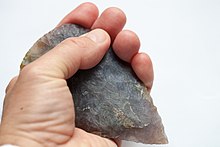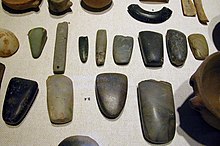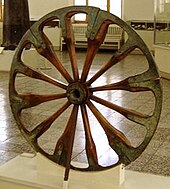Technology

 A steam turbine with the case opened, an example of energy technology
A steam turbine with the case opened, an example of energy technology
Technological advancements have led to significant changes in society. The earliest known technology is the stone tool, used during prehistoric times, followed by the control of fire, which contributed to the growth of the human brain and the development of language during the Ice Age. The invention of the wheel in the Bronze Age allowed greater travel and the creation of more complex machines. More recent technological inventions, including the printing press, telephone, and the Internet, have lowered barriers to communication and ushered in the knowledge economy.
While technology contributes to economic development and improves human prosperity, it can also have negative impacts like pollution and resource depletion, and can cause social harms like technological unemployment resulting from automation. As a result, there are ongoing philosophical and political debates about the role and use of technology, the ethics of technology, and ways to mitigate its downsides.
Etymology
Technology is a term dating back to the early 17th century that meant 'systematic treatment' (from Greek Τεχνολογία, from the Greek: τέχνη, romanized: tékhnē, lit. 'craft, art' and -λογία, 'study, knowledge').It is predated in use by the Ancient Greek word tékhnē, used to mean 'knowledge of how to make things', which encompassed activities like architecture.
Starting in the 19th century, continental Europeans started using the terms Technik (German) or technique (French) to refer to a 'way of doing', which included all technical arts, such as dancing, navigation, or printing, whether or not they required tools or instruments.At the time, Technologie (German and French) referred either to the academic discipline studying the "methods of arts and crafts", or to the political discipline "intended to legislate on the functions of the arts and crafts."Since the distinction between Technik and Technologie is absent in English, both were translated as technology. The term was previously uncommon in English and mostly referred to the academic discipline, as in the Massachusetts Institute of Technology.
In the 20th century, as a result of scientific progress and the Second Industrial Revolution, technology stopped being considered a distinct academic discipline and took on its current-day meaning: the systemic use of knowledge to practical ends.
Prehistoric
Main article: Prehistoric technology A person holding a hand axe
A person holding a hand axe
Tools were initially developed by hominids through observation and trial and error. Around 2 Mya (million years ago), they learned to make the first stone tools by hammering flakes off a pebble, forming a sharp hand axe.This practice was refined 75 kya (thousand years ago) into pressure flaking, enabling much finer work.
The discovery of fire was described by Charles Darwin as "possibly the greatest ever made by man". Archaeological, dietary, and social evidence point to "continuous [human] fire-use" at least 1.5 Mya.Fire, fueled with wood and charcoal, allowed early humans to cook their food to increase its digestibility, improving its nutrient value and broadening the number of foods that could be eaten. The cooking hypothesis proposes that the ability to cook promoted an increase in hominid brain size, though some researchers find the evidence inconclusive.Archaeological evidence of hearths was dated to 790 kya; researchers believe this is likely to have intensified human socialization and may have contributed to the emergence of language.
Other technological advances made during the Paleolithic era include clothing and shelter. No consensus exists on the approximate time of adoption of either technology, but archaeologists have found archaeological evidence of clothing 90-120 kya and shelter 450 kya. As the Paleolithic era progressed, dwellings became more sophisticated and more elaborate; as early as 380 kya, humans were constructing temporary wood huts.Clothing, adapted from the fur and hides of hunted animals, helped humanity expand into colder regions; humans began to migrate out of Africa around 200 kya, initially moving to Eurasia
Neolithic
Main article: Neolithic Revolution An array of Neolithic artifacts, including bracelets, axe heads, chisels, and polishing tools
An array of Neolithic artifacts, including bracelets, axe heads, chisels, and polishing tools
The Neolithic Revolution (or First Agricultural Revolution) brought about an acceleration of technological innovation, and a consequent increase in social complexity. The invention of the polished stone axe was a major advance that allowed large-scale forest clearance and farming.This use of polished stone axes increased greatly in the Neolithic but was originally used in the preceding Mesolithic in some areas such as Ireland.Agriculture fed larger populations, and the transition to sedentism allowed for the simultaneous raising of more children, as infants no longer needed to be carried around by nomads. Additionally, children could contribute labor to the raising of crops more readily than they could participate in hunter-gatherer activities.
With this increase in population and availability of labor came an increase in labor specialization. What triggered the progression from early Neolithic villages to the first cities, such as Uruk, and the first civilizations, such as Sumer, is not specifically known; however, the emergence of increasingly hierarchical social structures and specialized labor, of trade and war amongst adjacent cultures, and the need for collective action to overcome environmental challenges such as irrigation, are all thought to have played a role.
The invention of writing led to the spread of cultural knowledge and became the basis for history, libraries, schools, and scientific research.
Continuing improvements led to the furnace and bellows and provided, for the first time, the ability to smelt and forge gold, copper, silver, and lead – native metals found in relatively pure form in nature. The advantages of copper tools over stone, bone and wooden tools were quickly apparent to early humans, and native copper was probably used from near the beginning of Neolithic times (about 10 ka).Native copper does not naturally occur in large amounts, but copper ores are quite common and some of them produce metal easily when burned in wood or charcoal fires. Eventually, the working of metals led to the discovery of alloys such as bronze and brass (about 4,000 BCE). The first use of iron alloys such as steel dates to around 1,800 BCE.
Ancient
Main article: Ancient technology
Ancient technology
- Egyptian technology
- Indian technology
- Chinese technology
- Greek technology
- Roman technology
- Iranian technology
 The wheel was invented c. 4,000 BCE.
The wheel was invented c. 4,000 BCE.
After harnessing fire, humans discovered other forms of energy. The earliest known use of wind power is the sailing ship; the earliest record of a ship under sail is that of a Nile boat dating to around 7,000 BCE. From prehistoric times, Egyptians likely used the power of the annual flooding of the Nile to irrigate their lands, gradually learning to regulate much of it through purposely built irrigation channels and "catch" basins. The ancient Sumerians in Mesopotamia used a complex system of canals and levees to divert water from the Tigris and Euphrates rivers for irrigation.
Archaeologists estimate that the wheel was invented independently and concurrently in Mesopotamia (in present-day Iraq), the Northern Caucasus (Maykop culture), and Central Europe.Time estimates range from 5,500 to 3,000 BCE with most experts putting it closer to 4,000 BCE. The oldest artifacts with drawings depicting wheeled carts date from about 3,500 BCE. More recently, the oldest-known wooden wheel in the world was found in the Ljubljana Marsh of Slovenia.
The invention of the wheel revolutionized trade and war. It did not take long to discover that wheeled wagons could be used to carry heavy loads. The ancient Sumerians used a potter's wheel and may have invented it.A stone pottery wheel found in the city-state of Ur dates to around 3,429 BCE, and even older fragments of wheel-thrown pottery have been found in the same area. Fast (rotary) potters' wheels enabled early mass production of pottery, but it was the use of the wheel as a transformer of energy (through water wheels, windmills, and even treadmills) that revolutionized the application of nonhuman power sources. The first two-wheeled carts were derived from travoi and were first used in Mesopotamia and Iran in around 3,000 BCE.
The oldest known constructed roadways are the stone-paved streets of the city-state of Ur, dating to c. 4,000 BCE, and timber roads leading through the swamps of Glastonbury, England, dating to around the same period. The first long-distance road, which came into use around 3,500 BCE,[49] spanned 2,400 km from the Persian Gulf to the Mediterranean Sea, but was not paved and was only partially maintained. In around 2,000 BCE, the Minoans on the Greek island of Crete built a 50 km road leading from the palace of Gortyn on the south side of the island, through the mountains, to the palace of Knossos on the north side of the island. Unlike the earlier road, the Minoan road was completely paved. Photograph of the Pont du Gard in France, one of the most famous ancient Roman aqueducts[50]
Photograph of the Pont du Gard in France, one of the most famous ancient Roman aqueducts[50]
Ancient Minoan private homes had running water. A bathtub virtually identical to modern ones was unearthed at the Palace of Knossos. Several Minoan private homes also had toilets, which could be flushed by pouring water down the drain.The ancient Romans had many public flush toilets,which emptied into an extensive sewage system.The primary sewer in Rome was the Cloaca Maxima;construction began on it in the sixth century BCE and it is still in use today.
The ancient Romans also had a complex system of aqueducts,which were used to transport water across long distances. The first Roman aqueduct was built in 312 BCE. The eleventh and final ancient Roman aqueduct was built in 226 CE.Put together, the Roman aqueducts extended over 450 km but less than 70 km of this was above ground and supported by arches.



















































